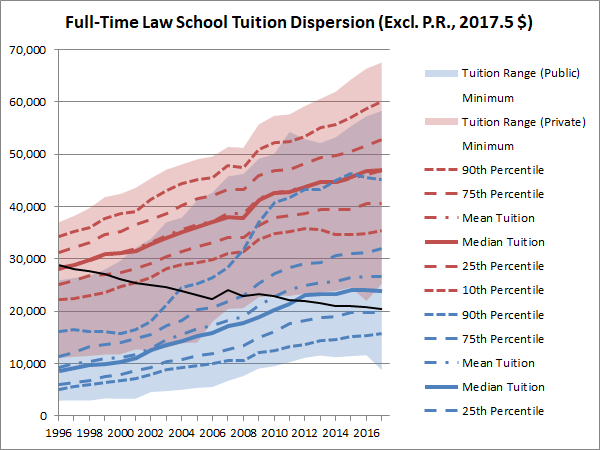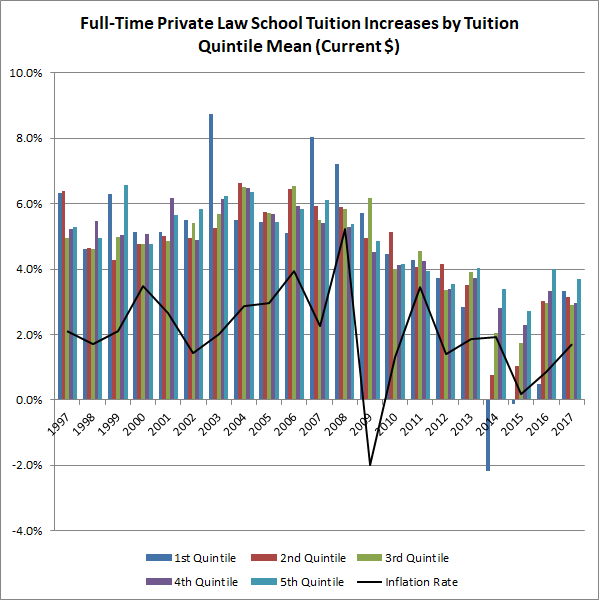Full-time tuition costs at private law schools rose an average 3.2 percent before adjusting for inflation. The rate is about half a point higher than last year’s increase, but it’s still well below the typical 5 percent rate before the Great Recession. For comparison, 2012 and 2013 saw increases of 3.7 percent and 3.6 percent, respectively. I focus on private law-school tuition because public law schools receive varying degrees of state subsidies, so they do not reflect the already distorted legal-education market’s prices.
Here’s what the dispersion of full-time private and full-time public (residential) tuition looks like going back to 1996:

Last year I pondered whether the public law school at the 25th percentile would begin charging more than the Stafford Loan limit of $20,500. It’s still one thousand dollars shy of it—in fact, it fell by $200 after adjusting for inflation. As of now, 10 percent of private law schools (12) charge more than $60,000, with the maximum at $67,564 (Columbia). It was only back in 2012 that the top 10 percent charged over $50,000 in nominal dollars, +$10,000 in five years.
In 2017, the median private law school charged $47,071 (between Pace and Suffolk); the mean was $46,843.
Unusually, costs grew consistently among private law schools. If we separate the law schools into quintiles, here’re the increases at the mean of each quintile.

From 2014-16, the tuition increases were stacked towards the high end, which was consistent with the prediction that the cheaper law schools were so fiscally crunched that they couldn’t afford to raise their costs any more. 2017 clearly breaks that trend, and along with its moderate mean increase the growth is distributed fairly evenly among private law schools.
The following private law schools raised their tuition charges by more than 5 percent:
- Widener (Delaware) (+12.0%)
- Liberty (+10.8%)
- La Verne (+10.2%)
- Elon (+10.0%)
- Brooklyn (+9.8%)
- Belmont (+8.9%)
- John Marshall (Atlanta) (+5.9%)
- Mississippi College (+5.6%)
- Mitchell|Hamline (+5.5%)
- Capital (+5.4%)
I would be cruel to ignore private law schools that cut their full tuition, so here’s that meager list:
- University of Tulsa (-33.6%)
- Howard University (-10.4%)
- Santa Clara University (-3.4%)
- Whittier Law School (-2.2%)
- Arizona Summit (-0.3%)
Yes, Tulsa’s one-third slash is the largest nominal tuition cut I can find going back to 1996. It beat Indiana Tech’s (-31.1 percent) last year (fat lot of good that did) and Ohio Northern’s (-26.4 percent) in 2014. Howard’s is fairly significant as well, particularly because in 2016 it raised tuition by 10.9 percent. Big raspberries go to Elon University which extended its students a -12.1 percent cut in 2015 only to mostly reverse it with a 10 percent hike this year.
Nine private law schools kept their full-tuition tags flat (Golden Gate, University of the Pacific, Western State, Ave Maria, St. Thomas (FL), Mercer, Illinois Institute of Technology, Western New England, and Vermont). Barry increased its costs by … $1.
Here are public law schools that cut their costs to resident students:
- University of Illinois (-7.8%)
- University of D.C. (-5.6%)
- University of New Mexico (-5.3%)
- Texas Tech University (-1.1%)
I note that D.C. and New Mexico both increased their costs last year by more than these decreases.
Overall, the size and character of the increases at private law schools was the same as last year, they were just distributed more evenly among law schools. The phenomenon of nominal tuition cuts is still marginal, and some schools appear to reverse their cuts shortly after instituting them.
Going forward, the thing to look out for is if Congress passes the PROSPER Act, which would cap federal loans to law students at $28,500 and fix a lifetime cap of $150,000 per student. If it does, then I predict that law schools will respond by serious restructuring: eliminating merit scholarships, slashing tuition to $28,500 plus whatever private lenders are willing to lend out, and getting rid of many faculty and their perks. I’m also sure many central universities will use the PROSPER Act as an opportunity to shut down their money-losing law schools.
Of course, this all assumes that the Bennett hypothesis is true, but AccessLex-funded research falsified it, so we all know law schools will raise their prices forever.
Full-time tuition costs don’t necessarily indicate what students are actually charged, but they do show how much rent law schools can extract from the government’s loan programs.
Information on this topic from prior years:
- “2016: Full-Time Private Law School Tuition Up 2.7 Percent” (December 27, 2016)
- “Full-Time Law School Tuition Still (Slowly) Rising” (December 22, 2015)
- “Law School Cuts Its Tuition to Zero (and Other 509 Report Errata)” (December 15, 2014)
- “The Official Guide is Dead, Long Live the Official Guide!” (March 31, 2014)
4 comments